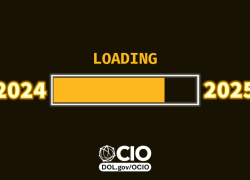
2022 was an impactful year for the Department of Labor’s Office of the Chief Information Officer. As American workers faced complexities bought on by a global pandemic, we continued to build on the momentum from previous years and innovate IT solutions to support the Department of Labor’s mission.
Here are a few highlights:
-
Our teams worked hard to raise the department’s Federal Information Technology Acquisition Reform Act (FITARA) rating. FITARA is a biannual Congressional indicator of how federal agencies manage, modernize, and secure their assets. We ended the year with an overall score of “B” and were one of only five agencies to score an “A” in the “Modernizing Government Technology” category.
-
We continued to enhance our IT infrastructure to protect workers’ confidential information. Our cybersecurity teams implemented widespread multi-factor authentication (MFA) to safeguard documents, achieving a 97% completion rate of use across IT systems. We also worked to encrypt data-in-transit to help protect American workers’ valuable information and assets.
-
We helped the department’s Employee Benefits Security Administration update their EFAST filing system, which supports federal requirements for reporting on employee benefit plans. The system saw a 5% increase in filings and 10% more users during the fiscal year.
-
The Foreign Labor Application Gateway system, administered by the department’s Employment and Training Administration, allows U.S. employers to find qualified workers while ensuring protections for U.S. and foreign workers. OCIO helped to implement several enhancements this year to improve customer service, broaden job opportunities and collect feedback. When compared to fiscal year 2021, the system saw a 26% increase in applications filed during FY 2022 by employers seeking prevailing wage determinations and labor certification to employ workers in temporary or seasonal employment in the United States.
-
The department’s Mine Safety and Health Administration launched a new app with our help this year to ensure miners have the information they need to stay safe on the job. Launched in August 2022, it received more than 5,000 downloads within the first two weeks – the most of any app we’ve released.
Emerging Technologies at the Department
2022 also ushered in more innovative work from OCIO using emerging technologies like Robotic Process Automation, or RPA, bots to automate repetitive tasks, helping save time and money. We took a human-centered approach by asking employees about how RPA could help with their day-to-day work and developing bots to address those needs. Some of these functions include populating information in fields within a PDF file, linking data sources to determine contractor responsibility and reconciling credit-card claims for student travel as part of Job Corps. RPA bots save thousands of hours of work, allowing department staff to focus their time on other tasks.
We also helped implement artificial intelligence (AI) as part of the Office of Workers’ Compensation (OWCP) benefits claims examination process. AI uses automation to help minimize the time department employees use to process forms manually, saving approximately 340 hours as well as costs. In turn, this helps enhance customer service, increase the accuracy of records and reduce processing time for disabled workers.
What’s Next for 2023?
There are a few projects we are very excited about in the new year.
One is helping eliminate paperwork for permanent labor certifications. The PERM visa modernization project (which relates to permanent labor certification) is supported by a $7.2 million award from the Technology Modernization Fund (TMF). It will help streamline the process for PERM filers to submit their applications, the process for PERM analysts to review applications and the process to submit labor certifications.
Currently the department processes 120,000 requests from 73,000 unique employers annually. This new workflow will make it easier for employers to access permanent labor certification services, shaving off 45 days and $1.5 million each year for PERM filers. It also will save the department $2.2 million annually by eliminating paper-based processes. In addition, once completed, the PERM Visa program will integrate within ETA’s FLAG system to help federal agencies securely share labor certification information.
OCIO will also continue work on data modernization, for which the department received an additional TMF award fund of $9.6 million to help improve the availability and accessibility of critical data to the public by:
-
Incorporating enterprise-standard predictive analytics and reporting capabilities in our IT infrastructure
-
Implementing enterprise data management capabilities
-
Supporting an application programming interface (API) and external data portal to transform how we share information internally and externally
2023 will be a transformative year for modernizing IT at the Department of Labor and we hope to build on the excellent work of our team to support America's workers, employers, job seekers and retirees – like you.
Editor’s note: If your New Year’s resolution includes finding a new job, we hope you will consider working with us. Visit our open job listings to find opportunities and be sure to follow us on Twitter and LinkedIn.
Lou Charlier is the deputy chief information officer for OCIO at the Department of Labor.

 U.S. Department of Labor Blog
U.S. Department of Labor Blog
